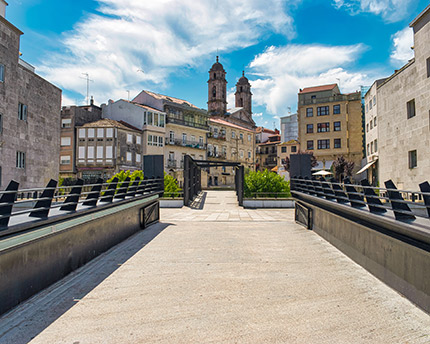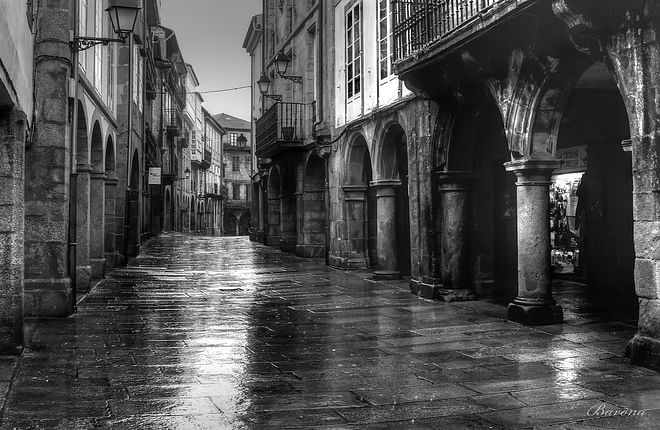No trip to Vigo is complete without passing through its old town. With a radius of barely two kilometres, visitors can comfortably cover this network of narrow streets and alleys in the oldest part of the city which reminds us of the Vigo of yesteryear. Get ready to discover a fascinating heritage that is bursting with legends.
The best place to start your tour of Vigo’s old town is the Peirao de Transatlánticos cruise ship pier. This is next to the city’s Tourist Office, which is beside the remains of the city’s old perimeter wall. You should then continue your walk uphill through the Praza da Princesa and the Porta do Sol and enjoy views from the top of the Paseo de Alfonso XII of the traditional seafaring neighbourhood of O Berbés. If you head downhill you will reach the Praza do Berbés, which is currently undergoing significant rehabilitation work. This square, which is lined with multiple archways, was once a beach on which the city’s fishermen moored their boats.
You could then pass along the Rúa Real which is lined with stately houses of the Bárcenas, Pazos and Figueroa families and the 15th century Casa de Ceta (also known as the Casa de Arines), which today houses the Camoes Institute of the Portuguese Language. The last stop on the route is the Praza da Constitución, which is home to the old City Hall and the Co-Cathedral of Santa María. From there, you can return to the Peirao de Transatlánticos and admire the city from the viewpoint of the Praza da Pedra.
History of Vigo’s old town
Vigo and its comarcal namesake have been inhabited since time immemorial. There are Stone Age remains and Neolithic tools on display in the Castrelos Municipal Museum. Vigo’s Romanization process lasted around 600 years, and evidence of this period can still be seen today. Only three churches and two bridges remain from the Medieval period, despite the fact that the first text which is known to mention Vigo, which was written in Latin, can be traced back to this period.
The town grew outwards during the Modern Age. Some documents reflect the importance of sardine fishing during that period. A perimeter wall with six access gates was built in 1665, and the morphology of the city as we know it today began to take shape.
Like many other cities, Vigo was occupied by Napoleon Bonaparte’s French army in 1809. However, such was Vigo’s resistance to the French advances that it received the title of the “Faithful, Loyal and Valiant” city. Vigo’s old town hosts an annual Celebration of the Reconquista, which includes various performances and other street activities to commemorate the struggle.
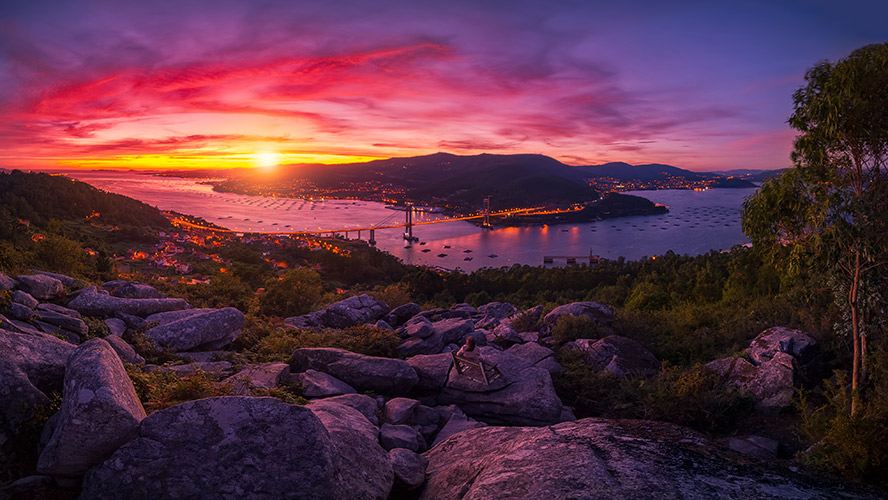
The 20th century brought about a great economic boom which saw the creation of new industries and the improvement of communication networks in and around the city. Increased job prospects attracted swathes of immigrants from the rural parts of Galicia, particularly from Ourense. Today, Vigo is a modern city with important industry and service sectors.
What is there to see in Vigo’s old town?
Vigo’s old town, or “Casco Vello”, is the most traditional and historical part of the city. As such, no visit to Vigo is complete without wandering around its network of steep and narrow streets and discovering some of its main tourist attractions.
Co-cathedral: Vigo’s co-cathedral, known officially as the Co-Cathedral of Santa María or the collegiate church, was built in 1811. It is notable for the fact that its sundial is not south-facing, which is unusual for this type of religious temple. It is home to the Christ of Victory sculpture, which is carried around the city in a procession on the first Sunday in August.
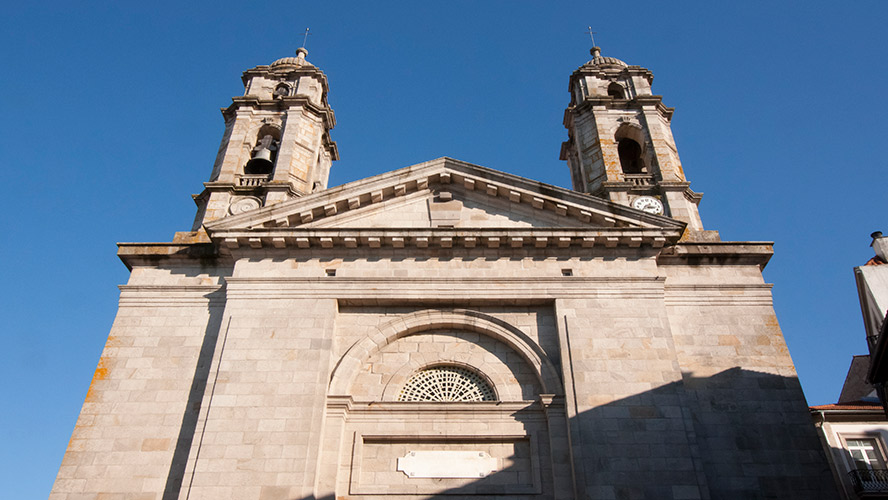
Square and market If there’s one thing Vigo is known for, it’s its fish and seafood. A visit to O Berbés’ square and, in particular, its market – which was once open-air but is now covered – is highly recommended during your time in the city. You are sure to be impressed by the sight of so much fresh fish and seafood. Back in the 19th century, the sea came all the way up to archways that line the market square.
Porta do Sol: The Porta do Sol, which is the site marking the absolute centre of Vigo, is the ideal place to kick-start a tour around the city centre that will end up at the top of O Castro mountain. It is at this point that you will discover the sculpture of O Sereo, or “The Fish Man”, which has become a true emblem of the city. Crafted by the Galician sculptor Francisco Leiro, it stands on a raised pedestal in the middle of the square. It must be said that it is not a universally popular sculpture, and that it has received praise and criticism in equal measure.
Galician House of Culture: Located in the old Vigo City Hall, this cultural centre hosts literary, artistic and performing arts activities on a daily basis.
Praza da Constitución: The Praza da Constitución, meaning ‘Constitution Square’, is the true epicentre of Vigo. The archways of this lively square serve to muffle the noise that is generated by high numbers of locals and tourists throughout the day. This is also the main site of the Maios and Reconquista ‘fiestas’.
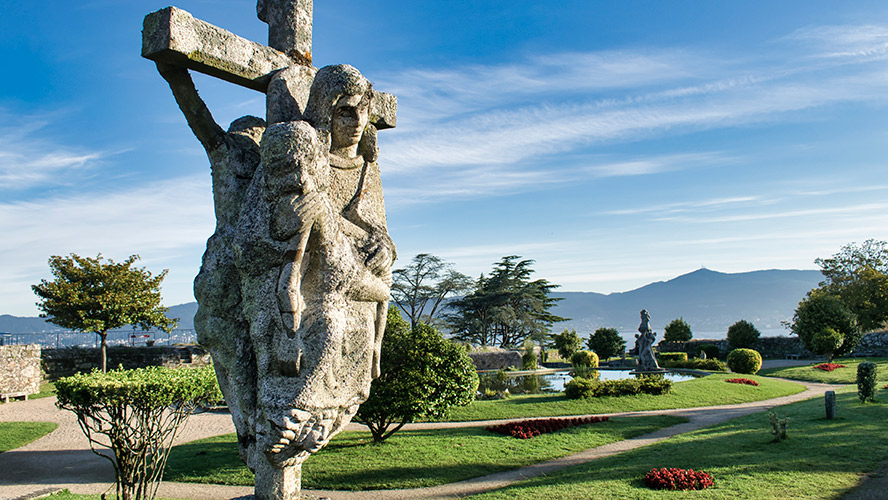
Where to eat in Vigo
Vigo is home to a plethora of excellent and highly regarded restaurants where you can experience the delights of the local Galician cuisine which is renowned for its fresh fish and seafood. Don’t leave without enjoying a seafood platter in Rúa da Laxe (known as the ‘Octopus Street’), some fried fish or peixiños, the traditional slow-roasted veal or the exquisite ‘llandera’ cake. You should also make an effort to experience the mysterious queimada. Some of Vigo’s most famous restaurants are La Trastienda del Cuatro, Rokuseki, Maruja Limón, Silabario, Casa Marco, Morrofino, El Mosquito, The Othilio Bar, Purosushi and Asador El Soriano.
Where to stay in Vigo
If you’re looking to explore Vigo’s old town and stay somewhere that guarantees a quiet and comfortable night’s sleep without breaking the bank, we recommend the Occidental Vigo hotel. This welcoming four-star establishment on the Galician city’s Via Norte is just a stone’s throw from the centre and enjoys magnificent views of the Vigo estuary. It has 104 modern and comfortable rooms with all kinds of amenities.





























































